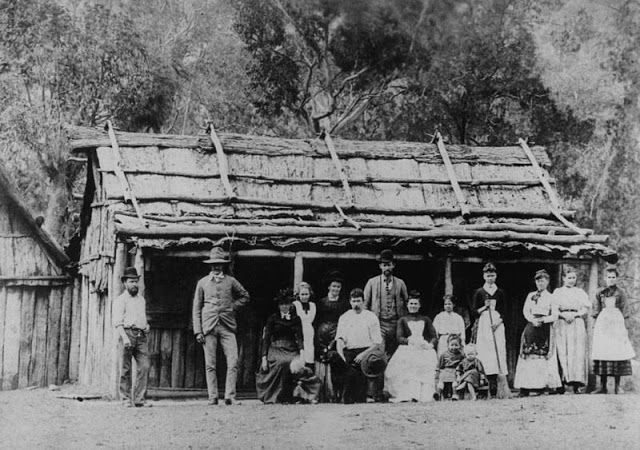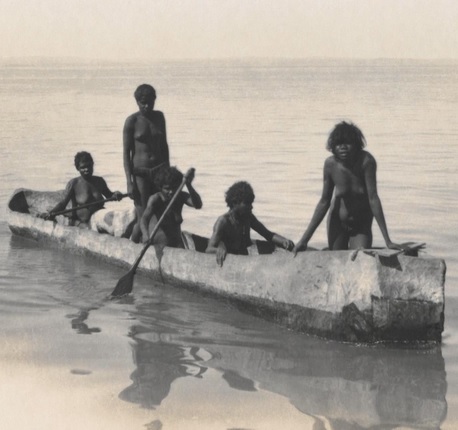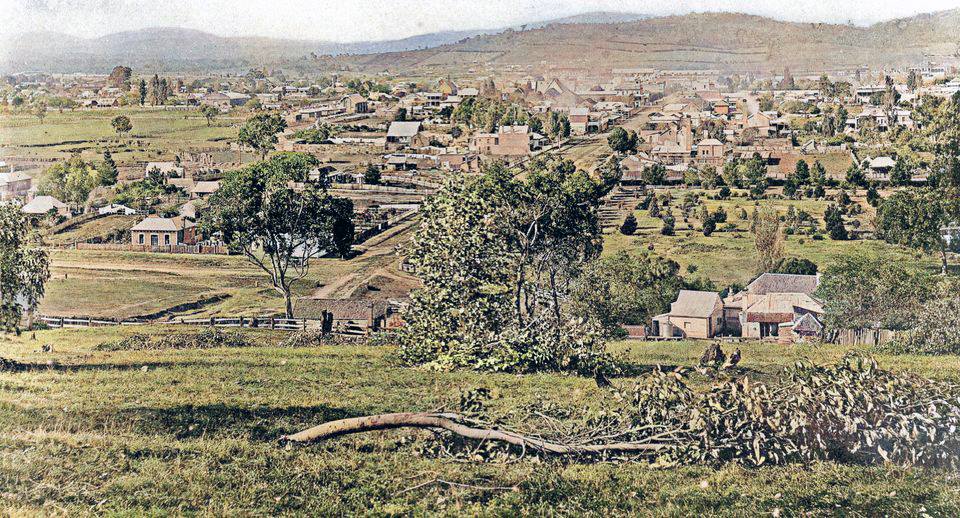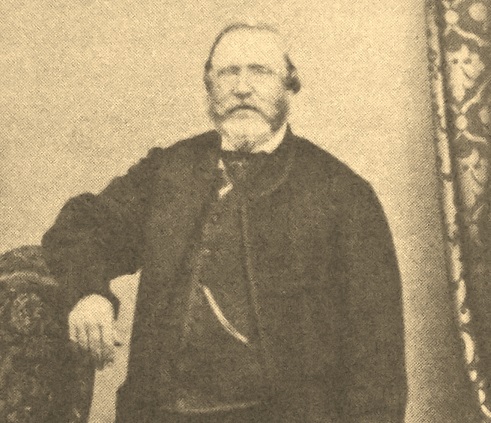Robert Brown arrived at the crossing place on the Murray River in mid-1838 (1) and opened a store and inn. Merriman showed Brown where to plant a garden and sow his crops above flood level and by April 1839 Brown’s corn crop was over 12 feet high. (2) According to Lady Jane Franklin, it was, ‘the finest looking I think I ever saw.’ (3)
Lady Jane Franklin gave a detailed account of Brown’s establishment writing he had 4 acres of maize and more in wheat. (3) AA Andrews believed this first crop was grown on the site of the Albury Botanic Gardens. (2)
Lady Jane Franklin also wrote the ‘ground requires no preparation but ploughing and harrowing.’ (3)
This is in accordance with current thinking that indigenous people tilled the land with digging sticks keeping it loose and clear of vegetation so tubers could be easily harvested. (4)
At this time Brown kept his cattle nearby and his sheep 18 miles away. (3)
In April 1839 there were two other dwellings at the crossing place, these being, the police hut and a hut belonging to a Mr Lewis whose cattle station was 2 miles on the Port Phillip side of the river. (3)
Lady Jane Franklin described Brown’s store as ‘spacious’ with 5 rooms but not yet fully stocked with merchandise. (3)
Brown himself, was described as stoutly built, of medium height, sandy hair, active and determined, very independent, but of a genial and charitable disposition. (2)
Brown is credited with being the first of Albury’s inhabitants to entertain vice royalty when Lady Franklin camped beside his inn for three or four days. (2)

Photo of a slab building in the manner of Robert Brown’s inn
Lady Jane Franklin wrote in her journal that Brown employed an indigenous man named Jem. She described him wearing, ‘a jacket and trousers, with his gun by his side and a pipe in his mouth.’ She said Jem was employed by Mr Brown to frighten crows from his field of maize. (3)
It is interesting to note the level of trust Robert Brown placed in Indigenous people. The Faithful massacre occurred just one year earlier and some of the Blacks at the crossing place, such as Merriman were said to have participated in the attack. Even so, Brown felt he could trust Jem with a loaded gun.
Lady Jane Franklin wrote, ‘The blacks in general in this neighbourhood are said to be quite quiet, but at Mr Brown’s sheep station 18 miles off, they had been spearing someone’s cattle.’ (3)
One year later, in 1840 Merriman was denied entry to the Mackay’s hut at Whorouly. Merriman complained to John Scobie Mackay saying he was welcome to enter Robert Brown’s hut so why not Mackay’s? (5)
It must be supposed that Robert Brown was considered a decent man by the local indigenous people.
Robert Brown opened an inn and store at the crossing place as traffic along the Sydney road rapidly increased. Overlanders were arriving regularly and usually consisted of about 14 men. They took a day or so to prepare before crossing the Murray with its strong treacherous currents which could cause accidents and deaths.
There were many ways to attempt the crossing. Some removed the wheels from their wagons and covered the dray with a canvas tarpaulin and using a rope strung from one side to the other pulled themselves across. Others used empty barrels tied to the sides of the wagons to keep them afloat while others urged their bullocks into the river and made them swim across pulling the heavy dray behind. (6)
Cattle and sheep were usually made to swim across, although there are reports of sheep, 40 at a time standing on the floating dray being hauled across.
George Hamilton crossed his sheep at the crossing place in late autumn 1837 and gave a detailed description in his book, “Experiences Of A Colonist’. (7)
Crossing the Murray River could be a dangerous affair as discovered by Rev Joseph Docker when he crossed in September 1838. His dray overturned and turned over and over in the water. He was lucky, only one bullock was lost. (1)
Regular accidents to human life occurred and GA Robinson wrote of the fresh grave on the sandhill of a drowned stockman. (8)
A traveller wrote of a man at Brown’s throwing a stone into the river indicating the place to cross.
Brown employed Merriman to take passengers and goods across the river in a canoe. (2) The canoe was said to be hollowed out of a red gum log and was purchased from James Gullifer when he quit Bonegilla. (1)
Albury historian AA Andrews gave further information about the canoe writing, ‘that Brown, ‘placed a ‘dugout’ canoe, attached to a rawhide rope stretched, across, to afford passage of the river, when high. This canoe was worked by an aboriginal, who went by the name of ‘Merriman.’ He was often the sole means of communication between the two sides of the river, when in flood.’ (2)

Photo of a dugout canoe made by Indigenous people.
Dugout canoes were usually made by burning out the middle with slow fires and are one of the oldest known vessels with examples found around the world dating back over 8,000 years.
David Mackenzie, in his book, Ten years in the Colony, wrote that the river could overrun its banks swelling two miles wide.
Robert Brown was born in Dublin and at the age of 8 travelled with his parents to the colony. His sister, Mary, married Aime Huon in 1834 linking Robert Brown with the Huon and Mitchell families. (10)
Paul, Charles and Aime Huon and their nephew, Thomas Mitchell took up land around the crossing place in 1837. Robert Brown was encouraged by his brother-in-laws to join them and seek his fortune. (10)
Robert Brown visited the crossing place in January 1838 and David Reid of Carraragamungee said he first met Brown at Yass when Brown was returning to Sydney after a reconnaissance to the crossing place. Brown told Reid he was pleased with what he saw and intended to return and begin a store. (1)
Robert Brown’s store was situated close to the Hovell tree. This was the tree that Hume and Hovell camped under on 17th November 1824. Hovell marked the occasion by carving his name and date on the tree. (2)

Photo of the Hovell tree showing monument hill in the distance
According to David Reid, Robert Brown looked after the engraving by occasionally cutting away the bark when it threatened to grow over the letters. (1)
AA Andrews also wrote Robert Brown was a blacksmith by trade and built a bark hut and forge on the bank of the river. (1)
Andrews said, ‘Near the door ‘Bob’ established a smithy, for the shoeing of horses, and repairing drays, etc. ‘Bob’ was middle aged, roughish in manner, but with a stock of good nature, which, in a real emergency, he would unstintingly apply.” (1)
A man named Barrett built a blacksmith shop beside Brown’s inn and found plenty of business. AA Andrews. (1)
In those days a blacksmith’s forge, an inn and a store for travellers to replenish supplies was the perfect business model. It meant you could drink an ale while you waited for your horse to be shod then stock up for the remainder of the journey.
William Bowman who took up Tarrawingee in 1838 used a similar model. He was a wheelwright by trade and ran an inn on the Wincarabee river at Bong Bong, NSW but sold in 1834 when the road was rerouted and his inn bypassed. He took up cattle and sheep farming, setting up Sutton Grange at Mt Alexander March 1838 and Tarrawingee station September 1838. (11)
In 1841 Brown’s sister, Eleanor and their mother and father, moved to Albury to be near their son and daughter, Mary. (Mary had married Aime Huon of Gerogery & Table Top) (10) (12)
In 1842 Brown obtained a liquor licence from Yass and opened up as the Hume inn.
But the most momentous event of 1842 for Robert Brown was on March 30th when he married Miss Anne Crowe at Campbelltown. (10) Brown was 29 and Anne was 17.
Robert and Anne had their first child, Frances Jane, on July 24th 1843. Francis was reputed to be the first white girl born in Albury. (10)
Anne Brown later said, ‘I looked out the window one morning to see the place surrounded by Blacks.’ (10)
Anne was only 18 at the time and said she was rather frightened. However, one of the Black girls managed to make her understand that the word had got around about the “white baby” and all they wanted was to see for it for themselves. (10)
By 1844, Robert Brown had established a punt across the Murray at the end of Hovell Street (which then extended down to the river) and charged £1 for a horse and dray. (2)
In 1845 Charles Huon married Robert’s sister, Eleanor Brown.
Robert and Anne Brown moved to Collendina in 1845, where eight of their ten children were born. The children were educated by a governess. (10)
Ann Brown was later to have a great understanding of, and affection for, the Black people. In her early days at “Collendina” they became part of her life. Strangers calling at the homestead could not understand how she was not nervous as she was often alone with her children when her husband was away, but she would assure them that the Blacks would not allow anyone to lay hands on her or her children. (10)
On May 24 each year (Queen Victoria’s birthday) Robert Brown distributed blankets and tomahawks to the Indigenous people of the area. (10)
The tribal Chief, King Bungambrawatha, commonly known as King Bill, was presented with a brass plate by Robert Brown. He was very proud of the gift and always wore it around his neck. He considered it a symbol of authority from the white man to rule. And rule he did in no uncertain manner, dealing out severe punishment to all who violated tribal law. (12)
Who was King Bungambrawatha? It is almost impossible for us to determine his identity.
Bungambrawartha was the original name of Albury. JFH Mitchell wrote the name as meaning deaf, dumb and blind. Bungambrawartha creek runs into the Murray River near where Brown had his inn.
King plates were given to Indigenous people who were seen as helpful to white settlers.
King Billy of the Barwidgee (whose name was Hon.ie.ap and was Merriman’s father ) wore a king plate and there is a photo of him taken in 1869 by Thomas Jetson Washborne at Yackandandah. This photo can be found at the State Library Melbourne.
When Robert Brown moved to Collendina to live, his father, Edward bought out Barret, the blacksmith. Then two years later Edward and his wife joined Robert and Anne at Collendina. (10) (12)
In 1859 Robert Brown was awarded a silver medal at the Albury and Murray River Agricultural and Horticultural Society’s annual exhibition for the first sample of oranges grown in the district. The present homestead is built on the spot where these first oranges were grown. (10)
His father and mother, Edward and Bridget Brown died at Collendina and were buried at Mulwala in 1862 and 1866. (10)
Robert Brown died at Collendina in February 1879. (10)
Arthur Andrews said Robert Brown was always one of the foremost in any movement, for the improvement of the district. His contributions to various funds were large, and cheerfully given, and it may be said, that several of Albury’s most useful institutions owed their origin and early support to him. He was fond of sport, and a well-known figure on more than one racecourse.
A severe accident sustained on the Corowa racecourse was the source of much suffering during his latter years. (10)
The following is an extract from an article printed in the Border Post by Robert Brown:
“When I settled down under the tree on which Mr Hume carved the name Hume River on November 17 1824, I could little imagine that so rapid a transformation would take place in a few short years, my only companions a few blacks, the kangaroo, the emu, the native dog. Now Albury can boast of its newspapers, fine buildings, steam mills, its churches, bank, courthouse etc.

view of Albury from monument hill
THE REFERENCES;
(1) Ogier’s reminiscences of David Reid, http://nla.gov.au/nla.obj-52773898
(2) AA Andrews article in The Albury Banner and Wodonga Express (NSW : 1871 – 1938 Fri 13 Oct 1911 Page 41 HISTORY OF ALBURY
(3) This Errant Lady, the journal of Lady Jane Franklin
(4) Bruce Pascoe, Dark Emu
(5) See this website, profile, Dr George Mackay
(6) See this website, profile, Joseph Hawdon
(7) George Hamilton, Experiences of a Colonist.
(8) GA Robinson, journal, 1839-52
(9) YACKANDANDAH IN 1838. SOME REMINISCENCES. BY MR. GEORGE KINCHINGTON.’ Ovens and Murray Advertiser, 16 Sept 1899, p.8.
(10) The Brown family at Corowa
(11) See this website, profile, William Bowman
(12) Robert Brown’s son, Frederick Brown wrote an article about his father that was printed in the Border Morning Mail of November 20, 1936,


